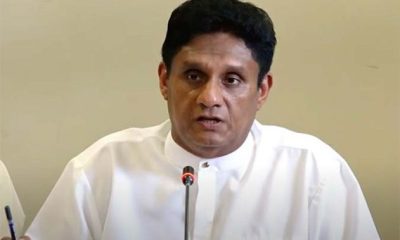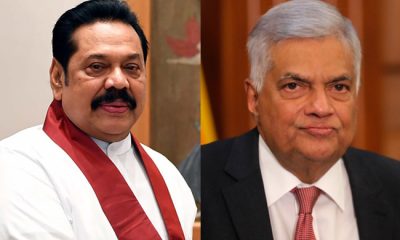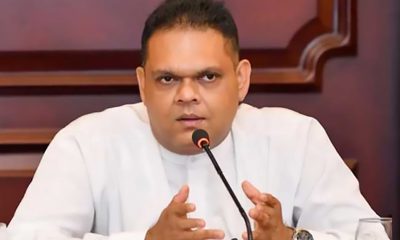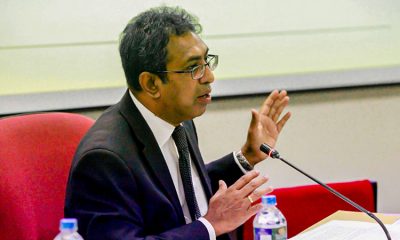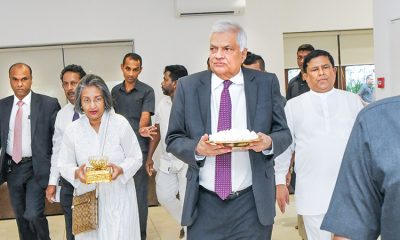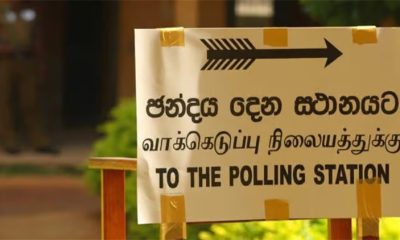Features
Presidential Dilemmas: Global Headwinds and Archaeological Mischiefs
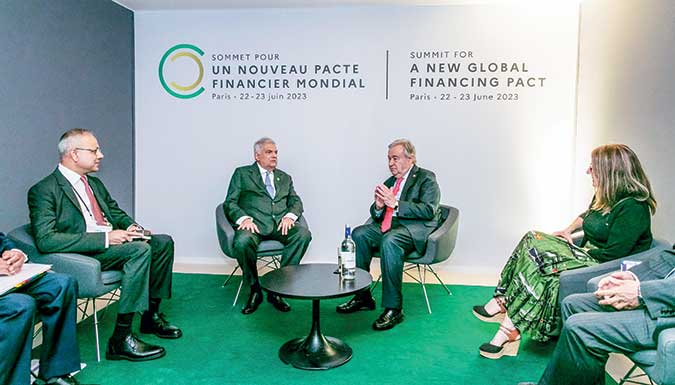
by Rajan Philips
Last week saw a spate of summits underscoring the global economic and geopolitical headwinds that governments and countries have to cope with and navigate through. First, there was the visit to China by the US Secretary of State Antony Blinken. This was followed by a state visit to Washington by India’s Prime Minister Narendra Modi. In London, British Prime Minister Sunak hosted the Ukraine Recovery Conference attended by delegates from 61 countries.
Last weekend, the African peace mission to Russia and Ukraine ended unproductively with Vladimir Putin politely dismissing what was apparently the first diplomatic initiative by African leaders outside their continent, and Volodymyr Zelensky responding lukewarmly to it. In France, President Emmanuel Macron presided over a two-day Summit for a New Global Financing Pact. President Ranil Wickremesinghe attended the Paris summit accepting the invitation from President Macron.
President Wickremesinghe made an official stopover in London, his third visit to the UK in recent months. The earlier two were for the funeral of Queen Elizabeth and the coronation of King Charles. Funerals and coronations are occasions for sidebar summits between attending leaders. Following his London visit last September to attend the Queen’s funeral, Mr. Wickremesinghe went to Tokyo for the funeral of Japanese Prime Minister Shinzo Abe, and from there to Manila for an official meeting at the Asian Development Bank. In November, he attended the UN Climate Conference in Sharm El Sheik, Egypt. So far this year, the President has been to London for the coronation, to Singapore and Japan on state visits, and now again to London and the Paris Summit. There will be more of them before the year is over.
The frequency of the President’s overseas travels shows the significance of the external factors that have a bearing on Sri Lanka’s economic crisis. At least that would be the travel justification that you can expect from the President’s Media Division. The visits also show that the President might be finding a comfort zone in his visits abroad, as well as an escape from domestic nuisances. He could also be more at home overseas than in the country. And more so when he has to engage in silly battles over archaeology in the course of his efforts to achieve the ever elusive national reconciliation.
Archaeological Mischiefs
The President is obviously determined to achieve both economic prosperity and national reconciliation. What is ironical is that while the President has set a generous time frame of 25 years (from now to 2048) to achieve economic prosperity, he seems stubborn about achieving national reconciliation almost overnight. In fact, he is already behind his own target date of achieving national reconciliation by February 4, 2023. It is not clear whether the President’s keenness to show early results on national reconciliation is for overseas benefits or for domestic purposes. It could be argued that without at least the appearance of efforts to achieve national reconciliation, it would be difficult to mobilize international support for overcoming the current economic difficulties, let alone achieve economic prosperity.
But every time the President initiates something on the reconciliation front, he is faced with backlashes from nationalist circles. Last Sunday, I literally went to town mocking the President as King Ranil. I must now add that if there is one area where the near monarchical powers of the President are checkmated and his executive initiatives could even be reversed, it is the area of national reconciliation.
The latest in the reconciliation saga is the spat over archaeology, which seems to have become one of the new state weapons for mischief making in ethno-territorial politics. The Tamil Political Parties have in unison been complaining about the Archaeological Department, Mahaweli Authority, Forest Department, Wildlife Department, Tourist Board and the Defence/Internal Security Ministry dabbling in ethno-territorial politics and impacting the livelihood of Tamil and Muslim people in the northern and eastern provinces.
The upshot of political mischief by state functionaries in the above-noted departments is either the eviction of people from their small and life-supporting settlements, or the refusal of permission to conduct essentially subsistence farming or other economic activities on lands where people live. On the other hand, according to Prageeth Karunathileka’s exposé in the Daily Mirror, the Department of Archaeology would seem to have had no qualms in allowing the Urban Development Authority to demolish the old buildings of the Bogambara Prison in Kandy, in spite of its palpably architectural and cultural value, to build a new commercial hotel in its place.
The current fracas is over the Archaeological Department declaring vast extents of land surrounding Buddhist Temples in Mullaitivu and Trincomalee as heritage sites and prohibiting even subsistence economic activities being undertaken on these lands. This has long become a bone of contention for Tamil and Muslim political parties who are constantly exposed to the difficulties experienced by their people. So, it was not surprising to see President Wickremesinghe himself weigh in on the matter at a meeting attended by Department officials and Tamil political leaders. He reportedly took to task the Director General of Archaeology, asking him whether the vihara in Mullaitivu could have more lands than the historic Maha Vihara in Anuradhapura. The Director, who is also an academic of sorts, has since resigned from his position as Director General.
Udaya Gammanpila has now picked up the baton and has announced a pilgrimage of sorts with 50 others to Mullaitivu. Four former SLPP parliamentarians including Channa Jayasumana, the pharmacological expert in gynecology, have asked the Speaker to appoint a Parliamentary Select Committee to investigate the alleged “large scale destruction of archaeological monuments in the North and East.” To cap it all the President has reportedly decided “to appoint an Expert Committee to conduct a formal inquiry and report on the claim of land area in extent of 5,000 acres for the Kurundi temple in the Mullaitivu District and Thiriyaya temple in the Trincomalee District for archaeological purposes.” How sillier can politics get? And nowhere else, but only in Sri Lanka.
The fount of the whole tamasha is the Presidential Task Force on Archaeology that Gotabaya Rajapaksa set in motion to appease his nationalist bidders and as his singular contribution to nation making in Sri Lanka. The irony is that he has been chased out of office for his economic blunders, but his legacy in archaeology is being reactivated by the same bidders who insist on digging for ancient remnants even if the country’s economy were to go to ruins.
The current caretaker President cannot put the genie in the bottle by creating another ‘Expert Committee’. There will always be those who will not agree with what the new Expert Committee will say, especially when the experts are identified as ‘Ranil’s experts.’ Nor can anything be achieved conclusively by rediscovering the lost legacy of Tamil Buddhism. It is not historical truths that are required for facilitating better political relationships among Sri Lanka’s ethnic groups, but principled political leadership and persistent commitment to take one doable initiative at a time, and one after the other as a constant work in progress.
The President must first acknowledge that reconciliation is slow burning cooking. There is no fast tracking of reconciliation and setting short timetables is not realistic but counterproductive. Second, what the President needs is not a task force or expert committee on archaeology, but an action committee of like minded political leaders in parliament. The President’s problem is that he has multiple minds internal to himself and he finds different like minded people for different purposes.
Such an approach is not conducive to creating lasting or permanent alliances, and it runs the risk of alienating the MPs who are more principled and attracting only the opportunists who will give their support for some personal benefit and extend their stay in parliament. The President’s SLPP support belongs to the latter category, and he can never count on them to support his reconciliation initiatives. On the other hand, the opposition MPs (SJB and JVP) who might be inclined to support him on reconciliation have been put off by his machinations on elections and his highhanded actions against protests.
The global context is not as comical as Sri Lanka’s archaeological tamashas, but it is far more complex and conflictual. The flurry of summits this week is indicative of that complexity and the urgency that every country, however small, seems to be recognizing, but no country, however big, seems to be having any control over. And there are more summits to come later this year, and a common President Wickremesinghe could be attending some of them. The Paris summit has created both optimism and skepticism.
On the one hand, it is being viewed as the new Bretton Woods that would reform the global financial architecture to narrow the gap between the global north and the global south by addressing the current challenges of debt, poverty and climate change. On the other hand, there is skepticism given President Macron’s penchant for launching international initiatives while producing little or no results. Not unlike President Wickremesinghe’s penchant for launching national reconciliation initiatives with no deliverables to show in the end.
(To be continued)
.
Features
The heart-friendly health minister

by Dr Gotabhya Ranasinghe
Senior Consultant Cardiologist
National Hospital Sri Lanka
When we sought a meeting with Hon Dr. Ramesh Pathirana, Minister of Health, he graciously cleared his busy schedule to accommodate us. Renowned for his attentive listening and deep understanding, Minister Pathirana is dedicated to advancing the health sector. His openness and transparency exemplify the qualities of an exemplary politician and minister.
Dr. Palitha Mahipala, the current Health Secretary, demonstrates both commendable enthusiasm and unwavering support. This combination of attributes makes him a highly compatible colleague for the esteemed Minister of Health.
Our discussion centered on a project that has been in the works for the past 30 years, one that no other minister had managed to advance.
Minister Pathirana, however, recognized the project’s significance and its potential to revolutionize care for heart patients.
The project involves the construction of a state-of-the-art facility at the premises of the National Hospital Colombo. The project’s location within the premises of the National Hospital underscores its importance and relevance to the healthcare infrastructure of the nation.
This facility will include a cardiology building and a tertiary care center, equipped with the latest technology to handle and treat all types of heart-related conditions and surgeries.
Securing funding was a major milestone for this initiative. Minister Pathirana successfully obtained approval for a $40 billion loan from the Asian Development Bank. With the funding in place, the foundation stone is scheduled to be laid in September this year, and construction will begin in January 2025.
This project guarantees a consistent and uninterrupted supply of stents and related medications for heart patients. As a result, patients will have timely access to essential medical supplies during their treatment and recovery. By securing these critical resources, the project aims to enhance patient outcomes, minimize treatment delays, and maintain the highest standards of cardiac care.
Upon its fruition, this monumental building will serve as a beacon of hope and healing, symbolizing the unwavering dedication to improving patient outcomes and fostering a healthier society.We anticipate a future marked by significant progress and positive outcomes in Sri Lanka’s cardiovascular treatment landscape within the foreseeable timeframe.
Features
A LOVING TRIBUTE TO JESUIT FR. ALOYSIUS PIERIS ON HIS 90th BIRTHDAY

by Fr. Emmanuel Fernando, OMI
Jesuit Fr. Aloysius Pieris (affectionately called Fr. Aloy) celebrated his 90th birthday on April 9, 2024 and I, as the editor of our Oblate Journal, THE MISSIONARY OBLATE had gone to press by that time. Immediately I decided to publish an article, appreciating the untiring selfless services he continues to offer for inter-Faith dialogue, the renewal of the Catholic Church, his concern for the poor and the suffering Sri Lankan masses and to me, the present writer.
It was in 1988, when I was appointed Director of the Oblate Scholastics at Ampitiya by the then Oblate Provincial Fr. Anselm Silva, that I came to know Fr. Aloy more closely. Knowing well his expertise in matters spiritual, theological, Indological and pastoral, and with the collaborative spirit of my companion-formators, our Oblate Scholastics were sent to Tulana, the Research and Encounter Centre, Kelaniya, of which he is the Founder-Director, for ‘exposure-programmes’ on matters spiritual, biblical, theological and pastoral. Some of these dimensions according to my view and that of my companion-formators, were not available at the National Seminary, Ampitiya.
Ever since that time, our Oblate formators/ accompaniers at the Oblate Scholasticate, Ampitiya , have continued to send our Oblate Scholastics to Tulana Centre for deepening their insights and convictions regarding matters needed to serve the people in today’s context. Fr. Aloy also had tried very enthusiastically with the Oblate team headed by Frs. Oswald Firth and Clement Waidyasekara to begin a Theologate, directed by the Religious Congregations in Sri Lanka, for the contextual formation/ accompaniment of their members. It should very well be a desired goal of the Leaders / Provincials of the Religious Congregations.
Besides being a formator/accompanier at the Oblate Scholasticate, I was entrusted also with the task of editing and publishing our Oblate journal, ‘The Missionary Oblate’. To maintain the quality of the journal I continue to depend on Fr. Aloy for his thought-provoking and stimulating articles on Biblical Spirituality, Biblical Theology and Ecclesiology. I am very grateful to him for his generous assistance. Of late, his writings on renewal of the Church, initiated by Pope St. John XX111 and continued by Pope Francis through the Synodal path, published in our Oblate journal, enable our readers to focus their attention also on the needed renewal in the Catholic Church in Sri Lanka. Fr. Aloy appreciated very much the Synodal path adopted by the Jesuit Pope Francis for the renewal of the Church, rooted very much on prayerful discernment. In my Religious and presbyteral life, Fr.Aloy continues to be my spiritual animator / guide and ongoing formator / acccompanier.
Fr. Aloysius Pieris, BA Hons (Lond), LPh (SHC, India), STL (PFT, Naples), PhD (SLU/VC), ThD (Tilburg), D.Ltt (KU), has been one of the eminent Asian theologians well recognized internationally and one who has lectured and held visiting chairs in many universities both in the West and in the East. Many members of Religious Congregations from Asian countries have benefited from his lectures and guidance in the East Asian Pastoral Institute (EAPI) in Manila, Philippines. He had been a Theologian consulted by the Federation of Asian Bishops’ Conferences for many years. During his professorship at the Gregorian University in Rome, he was called to be a member of a special group of advisers on other religions consulted by Pope Paul VI.
Fr. Aloy is the author of more than 30 books and well over 500 Research Papers. Some of his books and articles have been translated and published in several countries. Among those books, one can find the following: 1) The Genesis of an Asian Theology of Liberation (An Autobiographical Excursus on the Art of Theologising in Asia, 2) An Asian Theology of Liberation, 3) Providential Timeliness of Vatican 11 (a long-overdue halt to a scandalous millennium, 4) Give Vatican 11 a chance, 5) Leadership in the Church, 6) Relishing our faith in working for justice (Themes for study and discussion), 7) A Message meant mainly, not exclusively for Jesuits (Background information necessary for helping Francis renew the Church), 8) Lent in Lanka (Reflections and Resolutions, 9) Love meets wisdom (A Christian Experience of Buddhism, 10) Fire and Water 11) God’s Reign for God’s poor, 12) Our Unhiddden Agenda (How we Jesuits work, pray and form our men). He is also the Editor of two journals, Vagdevi, Journal of Religious Reflection and Dialogue, New Series.
Fr. Aloy has a BA in Pali and Sanskrit from the University of London and a Ph.D in Buddhist Philosophy from the University of Sri Lankan, Vidyodaya Campus. On Nov. 23, 2019, he was awarded the prestigious honorary Doctorate of Literature (D.Litt) by the Chancellor of the University of Kelaniya, the Most Venerable Welamitiyawe Dharmakirthi Sri Kusala Dhamma Thera.
Fr. Aloy continues to be a promoter of Gospel values and virtues. Justice as a constitutive dimension of love and social concern for the downtrodden masses are very much noted in his life and work. He had very much appreciated the commitment of the late Fr. Joseph (Joe) Fernando, the National Director of the Social and Economic Centre (SEDEC) for the poor.
In Sri Lanka, a few religious Congregations – the Good Shepherd Sisters, the Christian Brothers, the Marist Brothers and the Oblates – have invited him to animate their members especially during their Provincial Congresses, Chapters and International Conferences. The mainline Christian Churches also have sought his advice and followed his seminars. I, for one, regret very much, that the Sri Lankan authorities of the Catholic Church –today’s Hierarchy—- have not sought Fr.
Aloy’s expertise for the renewal of the Catholic Church in Sri Lanka and thus have not benefited from the immense store of wisdom and insight that he can offer to our local Church while the Sri Lankan bishops who governed the Catholic church in the immediate aftermath of the Second Vatican Council (Edmund Fernando OMI, Anthony de Saram, Leo Nanayakkara OSB, Frank Marcus Fernando, Paul Perera,) visited him and consulted him on many matters. Among the Tamil Bishops, Bishop Rayappu Joseph was keeping close contact with him and Bishop J. Deogupillai hosted him and his team visiting him after the horrible Black July massacre of Tamils.
Features
A fairy tale, success or debacle

Sri Lanka-Singapore Free Trade Agreement
By Gomi Senadhira
senadhiragomi@gmail.com
“You might tell fairy tales, but the progress of a country cannot be achieved through such narratives. A country cannot be developed by making false promises. The country moved backward because of the electoral promises made by political parties throughout time. We have witnessed that the ultimate result of this is the country becoming bankrupt. Unfortunately, many segments of the population have not come to realize this yet.” – President Ranil Wickremesinghe, 2024 Budget speech
Any Sri Lankan would agree with the above words of President Wickremesinghe on the false promises our politicians and officials make and the fairy tales they narrate which bankrupted this country. So, to understand this, let’s look at one such fairy tale with lots of false promises; Ranil Wickremesinghe’s greatest achievement in the area of international trade and investment promotion during the Yahapalana period, Sri Lanka-Singapore Free Trade Agreement (SLSFTA).
It is appropriate and timely to do it now as Finance Minister Wickremesinghe has just presented to parliament a bill on the National Policy on Economic Transformation which includes the establishment of an Office for International Trade and the Sri Lanka Institute of Economics and International Trade.
Was SLSFTA a “Cleverly negotiated Free Trade Agreement” as stated by the (former) Minister of Development Strategies and International Trade Malik Samarawickrama during the Parliamentary Debate on the SLSFTA in July 2018, or a colossal blunder covered up with lies, false promises, and fairy tales? After SLSFTA was signed there were a number of fairy tales published on this agreement by the Ministry of Development Strategies and International, Institute of Policy Studies, and others.
However, for this article, I would like to limit my comments to the speech by Minister Samarawickrama during the Parliamentary Debate, and the two most important areas in the agreement which were covered up with lies, fairy tales, and false promises, namely: revenue loss for Sri Lanka and Investment from Singapore. On the other important area, “Waste products dumping” I do not want to comment here as I have written extensively on the issue.
1. The revenue loss
During the Parliamentary Debate in July 2018, Minister Samarawickrama stated “…. let me reiterate that this FTA with Singapore has been very cleverly negotiated by us…. The liberalisation programme under this FTA has been carefully designed to have the least impact on domestic industry and revenue collection. We have included all revenue sensitive items in the negative list of items which will not be subject to removal of tariff. Therefore, 97.8% revenue from Customs duty is protected. Our tariff liberalisation will take place over a period of 12-15 years! In fact, the revenue earned through tariffs on goods imported from Singapore last year was Rs. 35 billion.
The revenue loss for over the next 15 years due to the FTA is only Rs. 733 million– which when annualised, on average, is just Rs. 51 million. That is just 0.14% per year! So anyone who claims the Singapore FTA causes revenue loss to the Government cannot do basic arithmetic! Mr. Speaker, in conclusion, I call on my fellow members of this House – don’t mislead the public with baseless criticism that is not grounded in facts. Don’t look at petty politics and use these issues for your own political survival.”
I was surprised to read the minister’s speech because an article published in January 2018 in “The Straits Times“, based on information released by the Singaporean Negotiators stated, “…. With the FTA, tariff savings for Singapore exports are estimated to hit $10 million annually“.
As the annual tariff savings (that is the revenue loss for Sri Lanka) calculated by the Singaporean Negotiators, Singaporean $ 10 million (Sri Lankan rupees 1,200 million in 2018) was way above the rupees’ 733 million revenue loss for 15 years estimated by the Sri Lankan negotiators, it was clear to any observer that one of the parties to the agreement had not done the basic arithmetic!
Six years later, according to a report published by “The Morning” newspaper, speaking at the Committee on Public Finance (COPF) on 7th May 2024, Mr Samarawickrama’s chief trade negotiator K.J. Weerasinghehad had admitted “…. that forecasted revenue loss for the Government of Sri Lanka through the Singapore FTA is Rs. 450 million in 2023 and Rs. 1.3 billion in 2024.”
If these numbers are correct, as tariff liberalisation under the SLSFTA has just started, we will pass Rs 2 billion very soon. Then, the question is how Sri Lanka’s trade negotiators made such a colossal blunder. Didn’t they do their basic arithmetic? If they didn’t know how to do basic arithmetic they should have at least done their basic readings. For example, the headline of the article published in The Straits Times in January 2018 was “Singapore, Sri Lanka sign FTA, annual savings of $10m expected”.
Anyway, as Sri Lanka’s chief negotiator reiterated at the COPF meeting that “…. since 99% of the tariffs in Singapore have zero rates of duty, Sri Lanka has agreed on 80% tariff liberalisation over a period of 15 years while expecting Singapore investments to address the imbalance in trade,” let’s turn towards investment.
Investment from Singapore
In July 2018, speaking during the Parliamentary Debate on the FTA this is what Minister Malik Samarawickrama stated on investment from Singapore, “Already, thanks to this FTA, in just the past two-and-a-half months since the agreement came into effect we have received a proposal from Singapore for investment amounting to $ 14.8 billion in an oil refinery for export of petroleum products. In addition, we have proposals for a steel manufacturing plant for exports ($ 1 billion investment), flour milling plant ($ 50 million), sugar refinery ($ 200 million). This adds up to more than $ 16.05 billion in the pipeline on these projects alone.
And all of these projects will create thousands of more jobs for our people. In principle approval has already been granted by the BOI and the investors are awaiting the release of land the environmental approvals to commence the project.
I request the Opposition and those with vested interests to change their narrow-minded thinking and join us to develop our country. We must always look at what is best for the whole community, not just the few who may oppose. We owe it to our people to courageously take decisions that will change their lives for the better.”
According to the media report I quoted earlier, speaking at the Committee on Public Finance (COPF) Chief Negotiator Weerasinghe has admitted that Sri Lanka was not happy with overall Singapore investments that have come in the past few years in return for the trade liberalisation under the Singapore-Sri Lanka Free Trade Agreement. He has added that between 2021 and 2023 the total investment from Singapore had been around $162 million!
What happened to those projects worth $16 billion negotiated, thanks to the SLSFTA, in just the two-and-a-half months after the agreement came into effect and approved by the BOI? I do not know about the steel manufacturing plant for exports ($ 1 billion investment), flour milling plant ($ 50 million) and sugar refinery ($ 200 million).
However, story of the multibillion-dollar investment in the Petroleum Refinery unfolded in a manner that would qualify it as the best fairy tale with false promises presented by our politicians and the officials, prior to 2019 elections.
Though many Sri Lankans got to know, through the media which repeatedly highlighted a plethora of issues surrounding the project and the questionable credentials of the Singaporean investor, the construction work on the Mirrijiwela Oil Refinery along with the cement factory began on the24th of March 2019 with a bang and Minister Ranil Wickremesinghe and his ministers along with the foreign and local dignitaries laid the foundation stones.
That was few months before the 2019 Presidential elections. Inaugurating the construction work Prime Minister Ranil Wickremesinghe said the projects will create thousands of job opportunities in the area and surrounding districts.
The oil refinery, which was to be built over 200 acres of land, with the capacity to refine 200,000 barrels of crude oil per day, was to generate US$7 billion of exports and create 1,500 direct and 3,000 indirect jobs. The construction of the refinery was to be completed in 44 months. Four years later, in August 2023 the Cabinet of Ministers approved the proposal presented by President Ranil Wickremesinghe to cancel the agreement with the investors of the refinery as the project has not been implemented! Can they explain to the country how much money was wasted to produce that fairy tale?
It is obvious that the President, ministers, and officials had made huge blunders and had deliberately misled the public and the parliament on the revenue loss and potential investment from SLSFTA with fairy tales and false promises.
As the president himself said, a country cannot be developed by making false promises or with fairy tales and these false promises and fairy tales had bankrupted the country. “Unfortunately, many segments of the population have not come to realize this yet”.
(The writer, a specialist and an activist on trade and development issues . )



